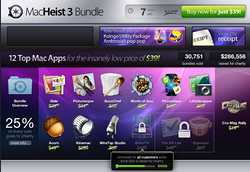I went to the Apple Store today with a friend that was looking at buying a MacMini and another friend that was picking up a copy of Snow Leopard, which sells for $29. That is, unless you’d like a copy for $25.
Apple’s policy toward operating systems has historically been a good one. There is no home, business, professional, expert, business, yadda-yadda-yadda flavors. There is no upgrade or full version. There is no pricing tier. Everything is one low price, you can upgrade or install fresh at any time.
And, if you buy a machine at the Apple Store it comes with the latest-and-greatest software, and if a new product on it comes out within 30-days, simply come back and pick up your updated version for either free or a very steeply discounted price. This is how it’s been at the Tyson’s Store for years. It shines of Apple customer service.
We went to the new Apple Store in Reston, VA and had the most disturbing news presented by Apple blue-shirt, John.
Unfortunately, I have no way of knowing at this time if what he told us is fact, fiction, or fallacy. So don’t take what you read here as gospel, but rather use it as guideline for formulating solid questions when you deal with Apple for the next few months.
#1) Apple had on display a Mac Box Set (OS X Snow Leopard, iLife ’09, and iWork ’09) for $169. My friend having iLife ’08 and iWork ’08 asked, “is it worth the cost to upgrade?” The Apple guy looked at us and said straight faced, “honestly, no… the features are minimal, just get Snow Leopard.” Now, I appreciate his honesty and opinion, and that alone commanded enough respect for me to retain trust in Apple — much like Macy’s sending people to Gimbel’s. However, I suspect we got lucky and that was not the Apple corporate line. Nor would pointing out you can get it for much less at about $114.
#2) We noticed the word “upgrade” all over the box and asked, “do you have to have Leopard installed to install this?” The answer, surprisingly, was yes. This was an upgrade and not a regular OS X disc like Apple historically has done. We were told that the real OS wasn’t coming out until December. Yes, December. When asked about machine recovery, he confessed they had a special version in the back they could use under dire emergencies. This begs the question if $29 is an upgrade price, with the ‘full’ OS will be the normal $120 later.
Update 31-Aug-2009: An Apple employee in BestBuy also confirmed what’s out now is an upgrade path. Although according to him, if you buy a new machine (with Leopard on it) you get the Snow Leopard update for free, which sounds like the Steve Jobs’s Apple policy we’re used to.
#3) When we asked about the MacMini, we were told that it had Leopard on it and that if we wanted Snow Leopard, we’d have to buy that for an additional $29. However, the electronic Apple Store online was selling MacMini’s with Snow Leopard already installed, without the extra cost. I probed deeply about this. Did the machines really have Leopard, and not Snow Leopard? Yes, the excuse was that they hadn’t moved inventory with the old OS on it. I asked if one simply got the upgrade for free like Tyson’s always used to do. Again, no. When I pointed out that buying online was the-cost-of-Snow-Leopard cheaper, I was met by an indifferent shrug.
All three of these things were very non-Apple.
Again, I don’t know if it was the sales person, the store in general, or Apple taking a page from the Microsoft book of marketing. But suffice it to say there was an abrupt halt on major purchases today.
Customers expect two things from a business, common sense and consistency. Price is often a very distance third.
A Side Note: Customer service plays a big role, and I have another Apple story which illustrates going above and beyond. In BestBuy, when we went to go get a copy of Snow Leopard, they were out of stock. However, while browsing another part of the store, the Apple employee came up and handed over a copy of Snow Leopard. Apparently, a FedEx shipment had just arrived, so he pulled one out of the box, and then hunted down our party in the whole store, on the off chance we hadn’t left yet. That’s service. You know that BestBuy’s floor staff would not have done that.


 While doing
While doing